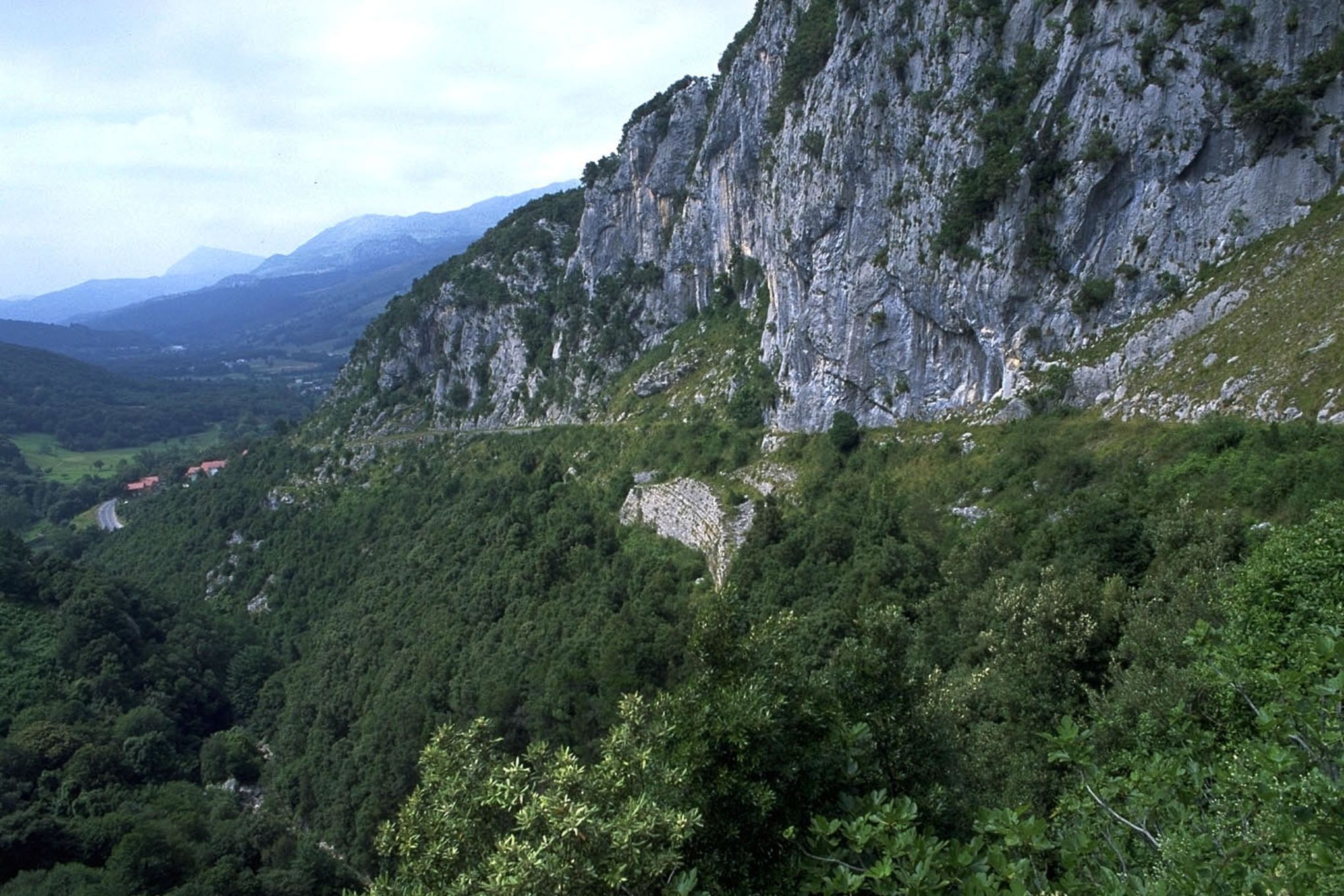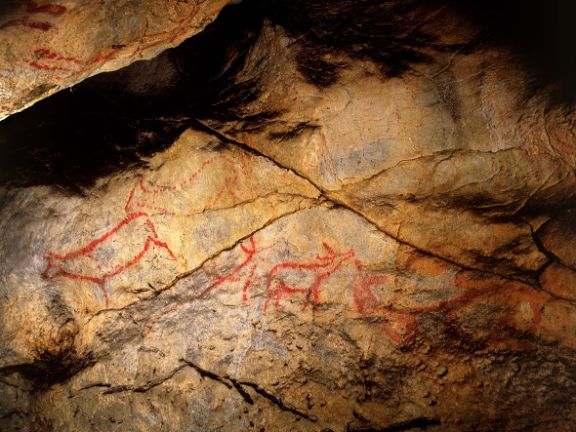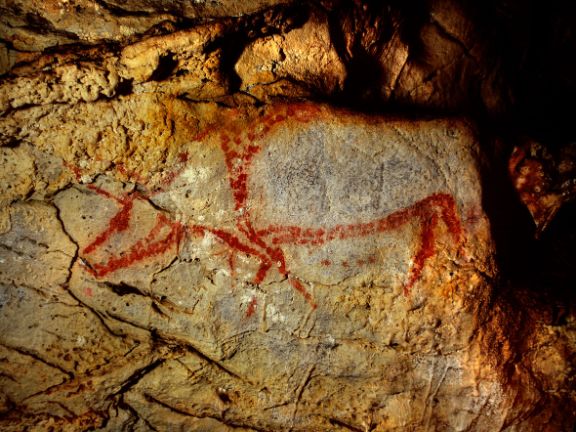Covalanas Cave

Identification of the Property
SubirMonte Pando, Ramales de la Victoria, Autonomous Community of Cantabria
Access
Take the N-629 south from Ramales de la Victoria towards Burgos. After two kilometres, take a turning to the left, to the car park and reception point for visitors. From here, walk up the track to the cave entrance. Brief description of the cave: The entrance is located in a high cliff face, overlooking the right bank of the River Calera. The cave immediately divides into two passages. The passage on the left runs for 30m, turns almost 90o for a length of 6m, before turning again until it is perpendicular to the short section. The passage on the right is practically straight, and varies little in its width, until it divides into a series of very narrow rifts. The floor of this passage was lowered in the 1950s to enable tourist visits, as it is the location of the Palaeolithic art.
Geographical coordinates
UTM 30T 463420E / 4788410N Z: 330
Descripción
SubirTopographic description
The cave opens on a high limestone cliff that dominates the right bank of the Calera River. Two galleries develop from a small entrance. The one on the left is a gallery that runs almost straight up to 30 m from the entrance, here it turns almost 90º and runs about 6 m, to turn again until it is oriented perpendicular to the small section mentioned above. The gallery on the right has a practically rectilinear development, with little variation in its width. The terminal area forks into small ducts, some of which are impassable. The floor of this gallery was lowered in the 50s of the 20th century to facilitate tourist access, since it is where the Paleolithic representations are located.Salto de línea
 Pulse para ampliar
Pulse para ampliar
 Pulse para ampliar
Pulse para ampliar
Date of Discovery
The paintings in Covalanas Cave were discovered in 1903, independently by Hermilio Alcalde del Río and Lorenzo Sierra.
Archaeological research
The first studies of the Palaeolithic art in the cave were published in 1906 and (more fully) in 1911; both written by Alcalde del Río, in the second case in collaboration with Breuil and Sierra. The ensemble was not revised until the 1980s, when it was studied by a research team from the University of Cantabria formed by Alfonso Moure, César González Sainz and Manuel Ramón González Morales. Their results were published in 1991. The latest research in the cave, which studied the cave art and its conservation, was carried out by Marcos García and Joaquín Eguizábal.
Artistic contents: paintings and engravings
Nearly all the figurative art in the cave is located in a 12m-long section of the right-hand passage, about 65m from the entrance. At this point the passage widens and is divided in two by a longitudinal wall. 89 In this part of the cave, there are 18 figures of hinds, a horse, a possible reindeer, a bovine and an animal that is difficult to interpret. They occupy both walls of the passage and also the space behind the longitudinal division. All the figures are painted in red, in most cases by using the technique of dabbing dots on the wall to form the outlines of the animals. The dots overlap in places, especially around the animal’s head, or are discontinuous, normally in the rear-quarters of the animal. One figure is also engraved. At the end of the passage there is a doubtful cervical-dorsal line and some red stains. Quadrangular signs, dots and other simple motifs complete the inventory. The grouping of animals, almost always hinds, is repeated several times, in two superimposed planes and both looking in the same direction.
One complex panel has several hinds lifting or turning their heads towards the same point located outside the panel. The final group on the right-hand wall has a large figure of a horse, surrounded by five heads or partial figures of hinds and a sign.
The paintings form a homogeneous group and can be included within Leroi-Gourhan’s Style III, in the archaic phase of Palaeolithic art, between the late Gravettian and early Solutrean periods. As well as the peculiar technique used to paint the figures, they display certain characteristic features, such as the triangular shape of the hinds’ heads or the two ears, open in a “V”-shape. This technique and style seen at Covalanas define a certain approach to Palaeolithic decoration known as the “Ramales School”, unique to northern Spain and particularly to the central sector of the region. As well as in the nearby La Haza Cave, it can be recognized at such sites as the Lower Gallery at La Garma, El Pendo, Salitre, Pasiega B and C, the caves in Carranza Gorge and Arenaza Cave. As well as the red paintings, the first part of the passage has numerous non-figurative black marks, which have been dated to the late Middle Ages.
Bibliography
SubirALCALDE DEL RÍO, H. 1906. Las pinturas y grabados de las cavernas prehistóricas de la provincia de Santander. Santander: Impr. de Blanchard y Arce.
ALCALDE DEL RÍO, H., BREUIL, H., SIERRA, L. 1911. Les cavernes de la région cantabrique (Espagne). Monaco: Impr. Veuve A. Chêne.
APELLÁNIZ, J. M. 1982. El arte prehistórico del País Vasco y sus vecinos. Bilbao: Ed. Desclée de Brouwer.
GARCÍA DÍEZ, M., EGUIZÁBAL TORRE, J. 2003. La cueva de Covalanas. El grafismo rupestre y la definición de territorios gráficos en el paleolítico cantábrico. Santander: Consejería de Cultura, Turismo y Deporte del Gobierno de Cantabria.
MOURE ROMANILLO, A., GONZÁLEZ MORALES, M. R., GONZÁLEZ SAINZ, C. 1990. Las pinturas rupestres paleolíticas de la cueva de Covalanas (Ramales de la Victoria, Cantabria). Trabajos de Prehistoria 47: 9-38.
MOURE ROMANILLO, A., GONZÁLEZ SAINZ, C., GONZÁLEZ MORALES, M. R. 1991. Las cuevas de Ramales de la Victoria (Cantabria). Arte rupestre paleolítico en las cuevas de Covalanas y La Haza. Santander: Servicio de Publicaciones de la Universidad de Cantabria.
ONTAÑÓN PEREDO, R. 2018. 10 Cuevas Patrimonio Mundial en Cantabria. Santander: Consejería de Educación, Cultura y Deporte - Gobierno de Cantabria / Asociación de Amigos del MUPAC”. Eliminar “APELLÁNIZ, J. M. 1982. El arte prehistórico del País Vasco y sus vecinos. Bilbao: Ed. Desclée de Brouwer.



